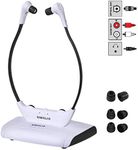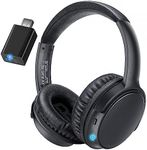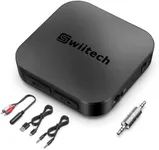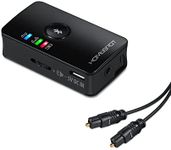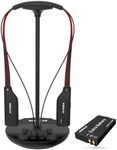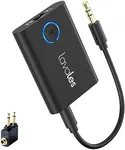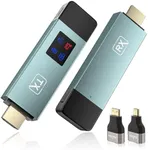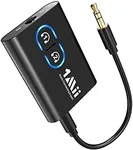Buying Guide for the Best Bluetooth TV Adapter For Hearing Aid
Choosing a Bluetooth TV adapter for your hearing aid can make watching television much more enjoyable and accessible. The right adapter will help you wirelessly stream audio from your TV directly to your hearing aids, reducing background noise and improving clarity. When shopping for a Bluetooth TV adapter, it's important to consider how it will connect to your TV, its compatibility with your hearing aids, and the quality of the audio transmission. Understanding the key specifications will help you find a device that fits your needs and ensures a seamless listening experience.Compatibility with Hearing AidsCompatibility refers to whether the Bluetooth adapter can connect directly to your specific hearing aids or if it requires an intermediary device. Some hearing aids have built-in Bluetooth, while others need a streamer or receiver. It's important to check if the adapter supports the Bluetooth version and protocols used by your hearing aids. If your hearing aids are made for direct streaming, look for adapters that support this feature. If not, you may need an additional accessory. Always verify compatibility to ensure smooth operation and avoid frustration.
Audio Output OptionsAudio output options describe how the adapter connects to your TV. Common outputs include optical (TOSLINK), RCA, 3.5mm headphone jack, and sometimes HDMI. The right choice depends on your TV's available ports. Optical and HDMI usually offer the best sound quality, while RCA and 3.5mm are more common on older TVs. Check your TV's back panel to see which outputs are available, and choose an adapter that matches. This ensures you can physically connect the adapter without needing extra converters.
Bluetooth VersionThe Bluetooth version determines the quality, range, and stability of the wireless connection. Newer versions (like Bluetooth 5.0 and above) offer better range, faster pairing, and lower latency, which means less delay between the TV and your hearing aids. Older versions may still work but could have more noticeable lag or connection drops. If you want the best experience, especially for watching TV where lip-sync is important, look for adapters with the latest Bluetooth version supported by your hearing aids.
Latency (Audio Delay)Latency is the delay between the TV audio and what you hear in your hearing aids. High latency can cause the sound to be out of sync with the picture, which is distracting. Some adapters support low-latency codecs like aptX Low Latency, which greatly reduce this delay. If you are sensitive to audio lag or watch a lot of shows where lip-sync matters, prioritize adapters that advertise low-latency performance. This will make your viewing experience much more natural.
RangeRange refers to how far you can be from the adapter and still receive a clear audio signal. Most Bluetooth adapters offer a range of about 10 meters (33 feet), but walls and other obstacles can reduce this. If you plan to move around your room or house while listening, look for adapters with a longer range. For most people who sit near the TV, standard range is sufficient, but if you want more freedom, consider this spec.
Multipoint ConnectivityMultipoint connectivity means the adapter can connect to more than one device at the same time, such as two sets of hearing aids or a hearing aid and a Bluetooth speaker. This is useful if you watch TV with someone else who also uses Bluetooth audio. If you often share your TV audio, look for this feature. If you watch alone, it's less important.
Ease of UseEase of use covers how simple it is to set up and operate the adapter. Some devices have clear instructions, easy pairing buttons, and indicator lights, while others can be more complicated. If you prefer a hassle-free experience, look for adapters with straightforward controls and good user reviews for simplicity. This is especially important if you are not comfortable with technology.

